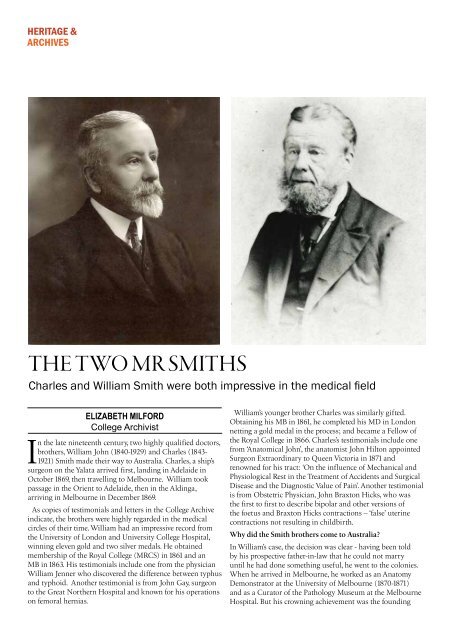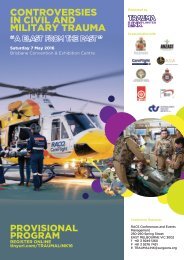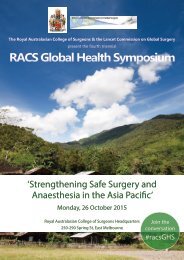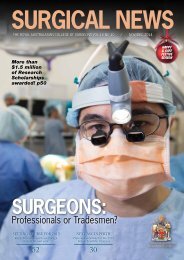You also want an ePaper? Increase the reach of your titles
YUMPU automatically turns print PDFs into web optimized ePapers that Google loves.
HERITAGE &<br />
ARCHIVES<br />
HERITAGE &<br />
ARCHIVES<br />
(with John Singleton) of the Melbourne Free Hospital<br />
for Sick Children in June 1870. Renamed the Children’s<br />
Hospital in 1903, the hospital was first established at the<br />
corner of Romeo Lane (now Crossley St), Melbourne,<br />
with six inpatient beds and a large number of outpatients.<br />
Elected Honorary Surgeon at the hospital, William was<br />
also Secretary of the Management Committee and Life<br />
Governor. However for some reason, he resigned in 1871 and<br />
travelled to Casterton in the Western Districts to work as a<br />
General Practitioner.<br />
William Smith sold his Casterton practice to his brother<br />
Charles in 1875, returned to England and married his<br />
sweetheart, Louise Crampton. Research in Germany<br />
followed then a Lectureship at the Oxford University. He<br />
died in York in 1929.<br />
Ostensibly Charles Smith came to Australia for his heath<br />
but his relationship with Lady Emily Shaftesbury may also<br />
have created difficulties for him. Explaining his decision<br />
to emigrate in a letter to her he says: ‘I am going to write<br />
to you what is a most painful disappointment to you…<br />
[ie parting company]’. Charles went to Melbourne with<br />
recommendations from WD Wilmot who had resided in<br />
the colony fourteen years earlier. Wilmot wrote:<br />
I trust the medical friends to whom I have written are still<br />
amongst the living and most flourishing of their Brethren in the<br />
Colony.<br />
Charles did flourish in the Colony, working as a resident<br />
physician at the Melbourne Hospital (1870) and physician<br />
at the newly completed hospital at Clunes (1875). He also<br />
married Marry Helen Brown, the granddaughter of ‘Como’<br />
Brown. Charles seemed to enjoy country life and after taking<br />
over his brother’s practice in Casterton, remained in the<br />
Western Districts until he retired to Melbourne. Charles lived<br />
at a time when country doctors worked both as surgeons and<br />
physicians and primarily regarded himself as a surgeon. His<br />
operations included an emergency tracheotomy in a train,<br />
using only a penknife, arthrodesis of the knee and removal of<br />
hydatid cysts in the liver and brain. A clever and meticulous<br />
man, he also developed an antiserum for diphtheria but was<br />
unsuccessful in convincing worthies like Lord Lister of its<br />
efficacy.<br />
Copies of the ‘Smith’ papers were given to the Archive by<br />
Charles Smith’s great grandson, Professor Ken Hardy. The<br />
papers give interesting insights into the medical personalities<br />
in 1860s Britain and also act as catalyst for investigating the<br />
lives of these two significant ‘colonial’ doctors.<br />
THE TWO MR SMITHS<br />
Charles and William Smith were both impressive in the medical field<br />
ELIZABETH MILFORD<br />
College Archivist<br />
In the late nineteenth century, two highly qualified doctors,<br />
brothers, William John (1840-1929) and Charles (1843-<br />
1921) Smith made their way to Australia. Charles, a ship’s<br />
surgeon on the Yalata arrived first, landing in Adelaide in<br />
October 1869, then travelling to Melbourne. William took<br />
passage in the Orient to Adelaide, then in the Aldinga,<br />
arriving in Melbourne in December 1869.<br />
As copies of testimonials and letters in the College Archive<br />
indicate, the brothers were highly regarded in the medical<br />
circles of their time. William had an impressive record from<br />
the University of London and University College Hospital,<br />
winning eleven gold and two silver medals. He obtained<br />
membership of the Royal College (MRCS) in 1861 and an<br />
MB in 1863. His testimonials include one from the physician<br />
William Jenner who discovered the difference between typhus<br />
and typhoid. Another testimonial is from John Gay, surgeon<br />
to the Great Northern Hospital and known for his operations<br />
on femoral hernias.<br />
William’s younger brother Charles was similarly gifted.<br />
Obtaining his MB in 1861, he completed his MD in London<br />
netting a gold medal in the process; and became a Fellow of<br />
the Royal College in 1866. Charles’s testimonials include one<br />
from ‘Anatomical John’, the anatomist John Hilton appointed<br />
Surgeon Extraordinary to Queen Victoria in 1871 and<br />
renowned for his tract: ‘On the influence of Mechanical and<br />
Physiological Rest in the Treatment of Accidents and Surgical<br />
Disease and the Diagnostic Value of Pain’. Another testimonial<br />
is from Obstetric Physician, John Braxton Hicks, who was<br />
the first to first to describe bipolar and other versions of<br />
the foetus and Braxton Hicks contractions – ‘false’ uterine<br />
contractions not resulting in childbirth.<br />
Why did the Smith brothers come to Australia?<br />
In William’s case, the decision was clear - having been told<br />
by his prospective father-in-law that he could not marry<br />
until he had done something useful, he went to the colonies.<br />
When he arrived in Melbourne, he worked as an Anatomy<br />
Demonstrator at the University of Melbourne (1870-1871)<br />
and as a Curator of the Pathology Museum at the Melbourne<br />
Hospital. But his crowning achievement was the founding<br />
Australian and New Zealand Post Fellowship Training Program<br />
in Colon and Rectal Surgery 2017<br />
Applications are invited for the two year Post Fellowship Colorectal Training Program, conducted by the<br />
Australia and New Zealand Training Board in Colon and Rectal Surgery (ANZTBCRS). The ANZTBCRS is a<br />
Conjoint Committee representing the Colon and Rectal Surgery Section, RACS, and the Colorectal Surgical<br />
Society of Australia and New Zealand (CSSANZ). The program is administered through the CSSANZ office.<br />
For details about the Training Program and applications, please see :<br />
https://cssanz.org/index.php/training/application-for-training-program<br />
Application Closing Date:<br />
Friday 6 May 2016<br />
Applications: All applicants must use the ANZTBCRS Application Template (see website link above).<br />
Please email your application to:<br />
A/Prof Andrew Stevenson<br />
Chair, Australia and New Zealand Training Board in Colon & Rectal Surgery<br />
Email secretariat@cssanz.org<br />
Phone +61 3 9853 8013<br />
<strong>SURGICAL</strong> <strong>NEWS</strong> APRIL 2016 45






